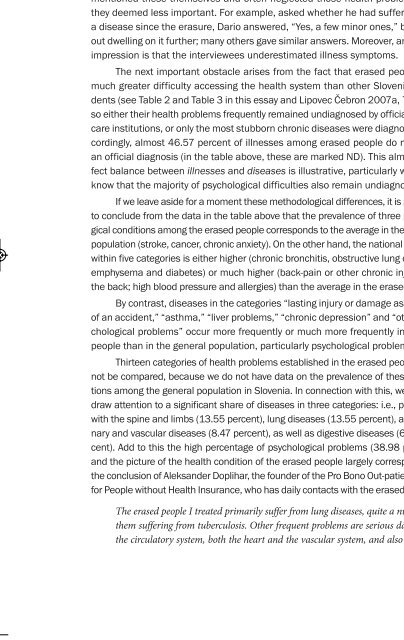The Scars of the Erasure_web
The Scars of the Erasure_web
The Scars of the Erasure_web
- No tags were found...
You also want an ePaper? Increase the reach of your titles
YUMPU automatically turns print PDFs into web optimized ePapers that Google loves.
<strong>Erasure</strong>_4a 10.1.11 20:29 Page 162162 THE SCARS OF THE ERASUREOne <strong>of</strong> <strong>the</strong> important methodological differences between <strong>the</strong> surveyHealth and Health Care in Slovenia and <strong>the</strong> semi-structured interviews whichhampers <strong>the</strong> comparison is that survey participants were <strong>of</strong>fered a list <strong>of</strong> di -seases and health conditions to choose from, unlike <strong>the</strong> erased people, whomentioned <strong>the</strong>se <strong>the</strong>mselves and <strong>of</strong>ten neglected those health problems that<strong>the</strong>y deemed less important. For example, asked whe<strong>the</strong>r he had suffered froma disease since <strong>the</strong> erasure, Dario answered, “Yes, a few minor ones,” but withoutdwelling on it fur<strong>the</strong>r; many o<strong>the</strong>rs gave similar answers. Moreover, an overallimpression is that <strong>the</strong> interviewees underestimated illness symptoms.<strong>The</strong> next important obstacle arises from <strong>the</strong> fact that erased people hadmuch greater difficulty accessing <strong>the</strong> health system than o<strong>the</strong>r Slovenian residents(see Table 2 and Table 3 in this essay and Lipovec Čebron 2007a, 70–75),so ei<strong>the</strong>r <strong>the</strong>ir health problems frequently remained undiagnosed by <strong>of</strong>ficial healthcare institutions, or only <strong>the</strong> most stubborn chronic diseases were diagnosed. Accordingly,almost 46.57 percent <strong>of</strong> illnesses among erased people do not havean <strong>of</strong>ficial diagnosis (in <strong>the</strong> table above, <strong>the</strong>se are marked ND). This almost perfectbalance between illnesses and diseases is illustrative, particularly when weknow that <strong>the</strong> majority <strong>of</strong> psychological difficulties also remain undiagnosed.If we leave aside for a moment <strong>the</strong>se methodological differences, it is possibleto conclude from <strong>the</strong> data in <strong>the</strong> table above that <strong>the</strong> prevalence <strong>of</strong> three patholo -gical conditions among <strong>the</strong> erased people corresponds to <strong>the</strong> average in <strong>the</strong> generalpopulation (stroke, cancer, chronic anxiety). On <strong>the</strong> o<strong>the</strong>r hand, <strong>the</strong> national averagewithin five categories is ei<strong>the</strong>r higher (chronic bronchitis, obstructive lung disease,emphysema and diabetes) or much higher (back-pain or o<strong>the</strong>r chronic injuries <strong>of</strong><strong>the</strong> back; high blood pressure and allergies) than <strong>the</strong> average in <strong>the</strong> erased group.By contrast, diseases in <strong>the</strong> categories “lasting injury or damage as a result<strong>of</strong> an accident,” “asthma,” “liver problems,” “chronic depression” and “o<strong>the</strong>r psychologicalproblems” occur more frequently or much more frequently in erasedpeople than in <strong>the</strong> general population, particularly psychological problems.Thirteen categories <strong>of</strong> health problems established in <strong>the</strong> erased people cannotbe compared, because we do not have data on <strong>the</strong> prevalence <strong>of</strong> <strong>the</strong>se conditionsamong <strong>the</strong> general population in Slovenia. In connection with this, we shoulddraw attention to a significant share <strong>of</strong> diseases in three categories: i.e., problemswith <strong>the</strong> spine and limbs (13.55 percent), lung diseases (13.55 percent), and coronaryand vascular diseases (8.47 percent), as well as digestive diseases (6.77 percent).Add to this <strong>the</strong> high percentage <strong>of</strong> psychological problems (38.98 percent)and <strong>the</strong> picture <strong>of</strong> <strong>the</strong> health condition <strong>of</strong> <strong>the</strong> erased people largely corresponds to<strong>the</strong> conclusion <strong>of</strong> Aleksander Doplihar, <strong>the</strong> founder <strong>of</strong> <strong>the</strong> Pro Bono Out-patient Clinicfor People without Health Insurance, who has daily contacts with <strong>the</strong> erased people:<strong>The</strong> erased people I treated primarily suffer from lung diseases, quite a number <strong>of</strong><strong>the</strong>m suffering from tuberculosis. O<strong>the</strong>r frequent problems are serious damage to<strong>the</strong> circulatory system, both <strong>the</strong> heart and <strong>the</strong> vascular system, and also legs and


